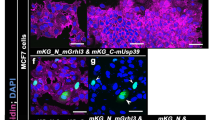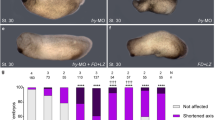Abstract
Several protein complexes that are involved in epithelial apicobasal polarity have been identified1. However, the mechanism by which these complexes interact to form an integrated polarized cell morphology remains unclear. Crumbs (Crb) and Lethal giant larvae (Lgl) are components of distinct complexes that regulate epithelial polarization in Drosophila melanogaster, but may not interact directly as they localize to the apical and basolateral membrane, respectively2,3,4,5,6,7,8,9. Nevertheless, a genetic screen identifies marked functional interactions between crb and lgl. These interactions extend to other genes within the crb (stardust, sdt) and lgl (discs large, dlg; scribble, scrib) pathways. Our findings suggest that the crb and lgl pathways function competitively to define apical and basolateral surfaces. They also suggest that in the absence of lgl pathway activity, the crb pathway is not required to maintain epithelial polarity. Moreover, we show that crb and lgl cooperate in zonula adherens formation early in development. At later stages, epithelial cells in these mutants acquire normal polarity, indicating the presence of compensatory mechanisms. We find that bazooka (baz) functions redundantly with crb/sdt to support apical polarity at mid- to late-embryogenesis. Despite regaining cell polarity, however, epithelial cells in crb and lgl pathway mutants fail to re-establish normal overall tissue architecture, indicating that the timely acquisition of polarized cell structure is essential for normal tissue organization.
This is a preview of subscription content, access via your institution
Access options
Subscribe to this journal
Receive 12 print issues and online access
$209.00 per year
only $17.42 per issue
Buy this article
- Purchase on Springer Link
- Instant access to full article PDF
Prices may be subject to local taxes which are calculated during checkout





Similar content being viewed by others
References
Tepass, U., Tanentzapf, G., Ward, R. & Fehon, R. Epithelial cell polarity and cell junctions in Drosophila. Annu. Rev. Genet. 35, 747–784 (2001).
Tepass, U., Theres, C. & Knust, E. crumbs encodes an EGF-like protein expressed on apical membranes of Drosophila epithelial cells and required for organization of epithelia. Cell 6, 787–799 (1990).
Tepass, U. & Knust, E. Phenotypic and developmental analysis of mutations at the crumbs locus, a gene required for the development of epithelia in Drosophila melanogaster. Roux Arch. Dev. Biol. 199, 189–206 (1990).
Wodarz, A., Grawe, F. & Knust, E. Crumbs is involved in the control of apical protein targeting during Drosophila epithelial development. Mech. Dev. 44, 175–187 (1993).
Wodarz, A., Hinz, U., Engelbert, M. & Knust, E. Expression of Crumbs confers apical character on plasma membrane domains of ectodermal epithelia of Drosophila. Cell 82, 67–76 (1995).
Manfruelli, P., Arquier, N., Hanratty, W. P. & Semeriva M. The tumor suppressor gene, lethal(2)giant larvae (1(2)g1), is required for cell shape change of epithelial cells during Drosophila development. Development 122, 2283–2294 (1996).
Bilder, D., Li, M. & Perrimon, N. Cooperative regulation of cell polarity and growth by Drosophila tumor suppressors. Science 289, 113–116 (2000).
Strand, D., Raska, I. & Mechler, B. M. The Drosophila lethal(2)giant larvae tumor suppressor protein is a component of the cytoskeleton. J. Cell Biol. 127, 1345–1360 (1994).
Tepass, U. Crumbs, a component of the apical membrane, is required for zonula adherens formation in primary epithelia of Drosophila. Dev. Biol. 177, 217–225 (1996).
Grawe, F., Wodarz, A., Lee., B., Knust, E. & Skaer, H. The Drosophila genes crumbs and stardust are involved in the biogenesis of adherens junctions. Development 122, 951–959 (1996).
Strand, D. et al. The Drosophila lethal(2)giant larvae tumor suppressor protein forms homo-oligomers and is associated with nonmuscle myosin II heavy chain. J. Cell Biol. 127, 1361–1373 (1994).
Gateff, E. Malignant neoplasms of genetic origin in Drosophila melanogaster. Science 200, 1448–1459 (1978).
Mechler, B. M., McGinnis, W. & Gehring W. J. Molecular cloning of lethal(2)giant larvae, a recessive oncogene of Drosophila melanogaster. EMBO J. 4, 1551–1557 (1985).
Ohshiro, T., Yagami, T., Zhang, C. & Matsuzaki, F. Role of cortical tumour-suppressor proteins in asymmetric division of Drosophila neuroblast. Nature 408, 593–596 (2000).
Peng, C. Y., Manning, L., Albertson, R. & Doe C. Q. The tumour-suppressor genes lgl and dlg regulate basal protein targeting in Drosophila neuroblasts. Nature 408, 596–600 (2000).
Tepass, U. & Knust, E. crumbs and stardust function in a genetic pathway that controls the organization of epithelia in Drosophila melanogaster. Dev. Biol. 158, 311–326 (1993).
Bachmann, A., Schneider, M., Theilenberg, E., Grawe, F. & Knust, E. Stardust, a novel Drosophila MAGUK, acts as a partner of Crumbs in the control of epithelial polarity. Nature 414, 638–643 (2001).
Hong, Y., Stronach, B., Perrimon, N., Jan, L. Y. & Jan, Y. N. stardust encodes a MAGUK protein that interacts with Crumbs to control polarity of epithelia but not neuroblasts in Drosophila. Nature 414, 634–638 (2001).
Roh, M. H. et al. The Maguk protein, Pals1, functions as an adapter, linking mammalian homologues of Crumbs and Discs Lost. J. Cell Biol. 157, 161–72 (2002).
Woods, D. F. & Bryant, P. J. The discs-large tumor suppressor gene of Drosophila encodes a guanylate kinase homolog localized at septate junctions. Cell 66, 451–464 (1991).
Bilder, D. & Perrimon, N. Localization of apical epithelial determinants by the basolateral PDZ protein Scribble. Nature 403, 676–680 (2000).
Perrimon, N. The maternal effect of lethal(1)discs-large-1: a recessive oncogene of Drosophila melanogaster. Dev. Biol. 127, 392–407 (1988).
Müller, H. A. & Wieschaus, E. armadillo, bazooka, and stardust are critical for early stages in formation of the zonula adherens and maintenance of the polarized blastoderm epithelium in Drosophila. J. Cell Biol. 134, 149–163 (1996).
Thomas, G. H. & Kiehart, D. P. βHeavy-spectrin has a restricted tissue and subcellular distribution during Drosophila embryogenesis. Development 120, 2039–2050 (1994).
Baumgartner, S. et al. A Drosophila neurexin is required for septate junction and blood-nerve barrier formation and function. Cell 87, 1059–1068 (1996).
White, K. et al. Genetic control of programmed cell death in Drosophila. Science 264, 677–683 (1994).
Kuchinke, U., Grawe, F. & Knust E. Control of spindle orientation in Drosophila by the Par-3-related PDZ-domain protein Bazooka. Curr. Biol. 8, 1357–1365 (1998).
Wodarz, A., Ramrath, A., Grimm, A. & Knust, E. Drosophila atypical protein kinase C associates with Bazooka and controls polarity of epithelia and neuroblasts. J. Cell Biol. 150, 1361–1374 (2000).
Petronczki, M. & Knoblich, J. A. DmPAR-6 directs epithelial polarity and asymmetric cell division of neuroblasts in Drosophila. Nature Cell Biol. 3, 43–49 (2001).
Fehon, R. G., Dawson, I. A. & Artavanis-Tsakonas, S. A Drosophila homologue of membrane-skeleton protein 4.1 is associated with septate junctions and is encoded by the coracle gene. Development 120, 545–557 (1994).
Cox, R. T., Kirkpatrick, C. & Peifer, M. Armadillo is required for adherens junction assembly, cell polarity, and morphogenesis during Drosophila embryogenesis. J. Cell Biol. 134, 133–148 (1996).
Tanentzapf, G., Smith, C., McGlade, J. & Tepass, U. Apical, lateral, and basal polarization cues contribute to the development of the follicular epithelium during Drosophila oogenesis. J. Cell Biol. 151, 891–904 (2000).
Tepass, U. Epithelial differentiation in Drosophila. Bioessays 19, 673–682 (1997).
Bhat, M. A. et al. Discs Lost, a novel multi-PDZ domain protein, establishes and maintains epithelial polarity. Cell 96, 633–645 (1999).
Pellikka, M. et al. Crumbs, the Drosophila homologue of human CRB1/RP12, is essential for photoreceptor morphogenesis. Nature 416, 143–149 (2002).
Medina, E. et al. Crumbs interacts with moesin and βHeavy-spectrin in the apical membrane skeleton of Drosophila. J. Cell Biol. 158, 941–951 (2002).
Chou, T. B. & Perrimon, N. The autosomal FLP-DFS technique for generating germline mosaics in Drosophila melanogaster. Genetics 144, 1673–1679 (1996).
Freeman, M. Reiterative use of the EGF receptor triggers differentiation of all cell types in the Drosophila eye. Cell 87, 651–660 (1996).
Brand, A. H. & Perrimon, N. Targeted gene expression as a means of altering cell fates and generating dominant phenotypes. Development 118, 401–415 (1993).
Tepass, U. & Hartenstein, V. The development of cellular junctions in the Drosophila embryo. Dev. Biol. 161, 563–596 (1994).
Acknowledgements
We thank M. Pellikka for expert assistance. We are grateful to H. Bellen, D. Bilder, D. Branton, P. Bryant, V. Budnik, R. Fehon, F. Matsuzaki, B. Mechler, A. Müller, G. Thomas, U. Thomas, A. Wodarz, the Bloomington Drosophila Stock Center and the Developmental Studies Hybridoma Bank for reagents. We thank D. Bilder for discussion of unpublished data and D. Godt for critical comments on the manuscript. This work was supported by a grant from the Canadian Institute of Health Research (to U.T.).
Author information
Authors and Affiliations
Corresponding author
Ethics declarations
Competing interests
The authors declare no competing financial interests.
Rights and permissions
About this article
Cite this article
Tanentzapf, G., Tepass, U. Interactions between the crumbs, lethal giant larvae and bazooka pathways in epithelial polarization. Nat Cell Biol 5, 46–52 (2003). https://doi.org/10.1038/ncb896
Received:
Revised:
Accepted:
Published:
Issue Date:
DOI: https://doi.org/10.1038/ncb896
This article is cited by
-
Apical–basal polarity and the control of epithelial form and function
Nature Reviews Molecular Cell Biology (2022)
-
Dlg5 maintains apical polarity by promoting membrane localization of Crumbs during Drosophila oogenesis
Scientific Reports (2016)
-
The PCP pathway regulates Baz planar distribution in epithelial cells
Scientific Reports (2016)
-
aPKC regulates apical localization of Lgl to restrict elongation of microridges in developing zebrafish epidermis
Nature Communications (2016)
-
Sticking together the Crumbs — an unexpected function for an old friend
Nature Reviews Molecular Cell Biology (2013)



